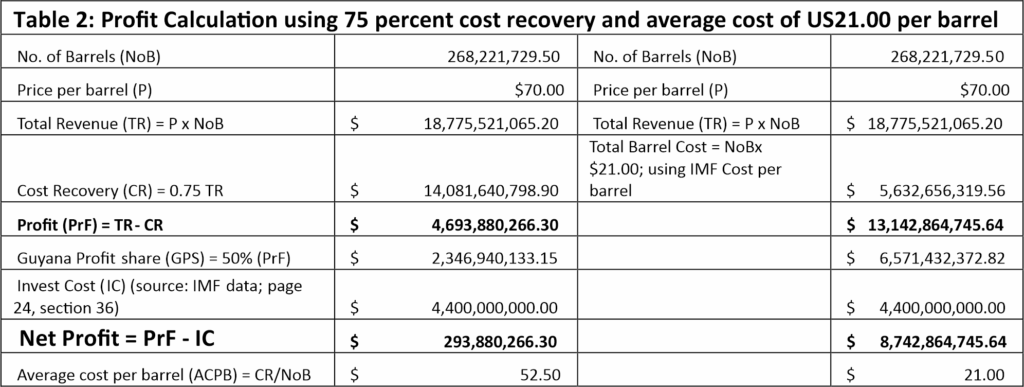Utilizing data reported by the International Monetary Fund (IMF), the Bank of Guyana (BoG) and Kaieteur News (KN), I will show that EEPGL has already recouped their investment; that they are earning significant profits; and that Guyana’s share will remain at meager levels for our non-renewal resource, unless the PSA is renegotiated.
According to the KN report dated July 10, 2023, captioned, ‘US$657M received for this year but US$905M already racked up in debts’ and the BoG Report, ‘Natural Resource Fund: Jan 1 -March 31, 2023: Table 6 page 17, Appendix 9’(https://bankofguyana.org.gy/bog/images/accounts_budgeting/natural_resource_fund/quarterly/nrf-march2023-quarterly.pdf), it is recorded that the value of total profit oil that Guyana received during the period March 11, 2020 to June 16, 2023 amounted to US$2.347 Billion, with the total profit of US$4.694 Billion being shared equally between Guyana and EEPGL. More importantly, the share of total revenue (14.5 Percent) that Guyana received is estimated at US$2.722Billion as compared with US$16.053 Billion (85.5 percent), given that a total number of extracted barrels of oil is 268.22Million of which Guyana received 38.89Million barrels, and 229.32Million barrels for EEPGL at an average price per barrel of US$70.00 (Table 1).

From the revenue and oil distribution described in Table 1, it is observed that for every barrel of oil that Guyana receives, EEPGL captures 5.90 barrels; and this is the fundamental inequity that must be changed. Also, it is very important that the number of the barrels of oil extracted must be included in the Natural Resource Fund Report, as this will provide a more complete understanding of the total revenue generated in this extractive industry.
In the PSA, cost recovery is set at 75 percent of total revenue (US$ 18.775 Billion) and this amounts to US$14.08 Billion, yielding an average cost per barrel of US$52.50 and total profit of US$4.693 Billion (Table 2). This average cost per barrel of oil is expensive, recognizing that the International Monetary Fund (IMF) estimated the cost of a barrel of oil is US$21.00 (IMF Report: https://nextcloud.a193.ca/s/5i4nxPPTnnPrZbr; page 22, section 36). The main implication of this much lower cost structure by the IMF is that the total cost of the 268.2 billion barrel of oil is US$5.632 Billion, yielding a profit of 13.14 Billion of which Guyana should receive US$6.57 Billion. Under the current PSA, Guyana profit share is only US$2.346 Billion, resulting in a shortage of US$4.225 Billion due to the current cost recovery method which hide profits and inflates cost, thereby significantly benefiting EEPGL at Guyana’s expense.

Furthermore, the same IMF report on page 22 also noted that the total investment cost for the initial project was US$4.4 Billion. Therefore, paying off the US$ 4.4 Billion investment cost plus the cost recovery of US$14.081 Billion from the Total Revenue of US$ 14.08 Billion yields a net profit of US$293.88 Million. Likewise, when the average cost of a barrel of oil is US$21.00, and this average cost per barrel is applied to the total barrels of oil sold (268.22Million), along with adding the investment costs, the net profit is US$8.742 Billion. Obviously, using the same total revenue of US$18.775 Billion in both methods, the cost recovery pathway yields far less net-profit (US$293.88 Million), as compared with the alternative method which generates a net profit of US$ 8.74 Billion. Consequently, it is pellucid that the cost recovery method in the PSA is a Ploy to Plunder Profits for EEPGL; and therefore, the PSA must be renegotiated to produce an equitable outcome before the oil in Liza 1 and 2 are exhausted.
Sincerely,
Dr. C. Kenrick Hunte
Professor and Former Ambassador
Article originally published at: https://www.kaieteurnewsonline.com/2023/07/13/eepgl-a-ploy-to-plunder-oil/











